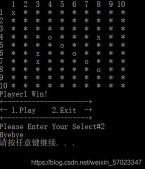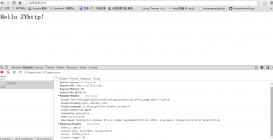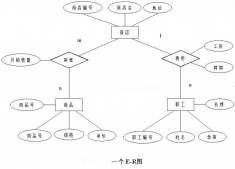在一个类中,如果类没有指针成员,一切方便,因为默认合成的析构函数会自动处理所有的内存。但是如果一个类带了指针成员,那么需要我们自己来写一个析构函数来管理内存。在<<c++ primer>> 中写到,如果一个类需要我们自己写析构函数,那么这个类,也会需要我们自己写拷贝构造函数和拷贝赋值函数。
析构函数:
我们这里定义一个类HasPtr,这个类中包含一个int 类型的指针。然后定义一个析构函数,这个函数打印一句话。
HasPtr.h 类的头文件
|
1
2
3
4
5
6
7
8
9
10
11
12
13
14
15
16
17
18
19
20
21
|
#pragma once#ifndef __HASPTR__#define __HASPTR__class HasPtr{public: HasPtr(int i,int *p); //HasPtr& operator=(HasPtr&); //HasPtr(const HasPtr&); ~HasPtr(); int get_ptr_value(); void set_ptr_value(int *p); int get_val(); void set_val(int v);private: int val; int *ptr;};#endif // !__HASPTR__ |
HasPtr.cpp 类的实现
|
1
2
3
4
5
6
7
8
9
10
11
12
13
14
15
16
17
18
19
20
21
22
23
24
25
26
27
28
29
30
31
32
33
34
35
36
37
|
#include "stdafx.h"#include <iostream>#include "HasPtr.h"using namespace std;HasPtr::HasPtr(int i, int *p){ val = i; ptr = p;}int HasPtr::get_ptr_value(){ return *ptr;}void HasPtr::set_ptr_value(int *p){ ptr = p;}int HasPtr::get_val(){ return val;}void HasPtr::set_val(int v){ val = v;}HasPtr::~HasPtr(){ cout << "destructor of HasPtr " << endl;} |
ClassWithPointer 类,包含main入口,HasPtr在stack上。
|
1
2
3
4
5
6
7
8
9
10
11
12
13
14
15
16
17
18
|
// ClassWithPointer.cpp : 定义控制台应用程序的入口点。//#include "stdafx.h"#include <iostream>#include "HasPtr.h"using namespace std;int main(){ int temp = 100; HasPtr ptr(2,&temp); cout << ptr.get_ptr_value() << endl; cout << ptr.get_val() << endl; system("PAUSE"); system("PAUSE"); return 0;} |
执行该入口方法,发现最后还是打印了析构函数这句话,OK,在main 方法中,stack上定义了一个HasPtr,在main方法退出前,析构函数自动调用了。
如果将HasPtr改为动态对象,也就是放在堆上呢?
ClassWithPointer 类,包含main入口,HasPtr在heap上。
|
1
2
3
4
5
6
7
8
9
10
11
12
13
14
15
16
17
18
|
// ClassWithPointer.cpp : 定义控制台应用程序的入口点。//#include "stdafx.h"#include <iostream>#include "HasPtr.h"using namespace std;int main(){ int temp = 100; //HasPtr ptr(2,&temp); HasPtr *ptr = new HasPtr(2,&temp); cout << ptr->get_ptr_value() << endl; cout << ptr->get_val() << endl; system("PAUSE"); return 0;} |
执行一下,发现析构函数没有调用。OK,我们在return 0前面添加一个delete ptr; 析构函数执行了。
所以,这里有两个结论:
- 当一个对象在stack 上时,析构函数自动调用。
- 当一个对象在heap上时,需要调用delete 语句,析构函数才会被执行。
现在在析构函数中调用delete 语句来删除指针成员。
头文件不变,HasPtr.cpp 文件代码如下:
|
1
2
3
4
5
6
7
8
9
10
11
12
13
14
15
16
17
18
19
20
21
22
23
24
25
26
27
28
29
30
31
32
33
34
35
36
37
38
|
#include "stdafx.h"#include <iostream>#include "HasPtr.h"using namespace std;HasPtr::HasPtr(int i, int *p){ val = i; ptr = p;}int HasPtr::get_ptr_value(){ return *ptr;}void HasPtr::set_ptr_value(int *p){ ptr = p;}int HasPtr::get_val(){ return val;}void HasPtr::set_val(int v){ val = v;}HasPtr::~HasPtr(){ cout << "destructor of HasPtr " << endl; delete ptr;} |
ClassWithPointer 代码如下:
|
1
2
3
4
5
6
7
8
9
10
11
12
13
14
15
16
17
|
// ClassWithPointer.cpp : 定义控制台应用程序的入口点。//#include "stdafx.h"#include <iostream>#include "HasPtr.h"using namespace std;int main(){ int temp = 100; HasPtr ptr(2,&temp); cout << ptr.get_ptr_value() << endl; cout << ptr.get_val() << endl; system("PAUSE"); return 0;} |
执行一下,正常打印结束后,抛出错误:
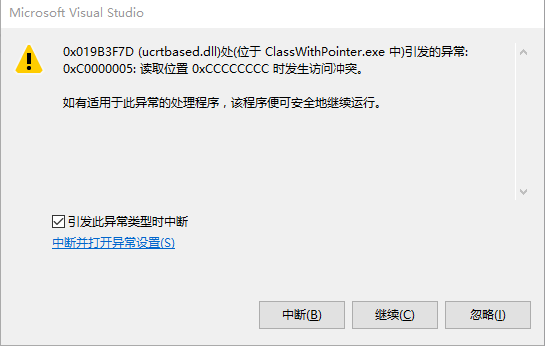
这里说明delete 不能删除stack 上的指针值。
现在在ClassWithPointer传入一个动态指针来测试一下。
|
1
2
3
4
5
6
7
8
9
10
11
12
13
14
15
16
17
|
// ClassWithPointer.cpp : 定义控制台应用程序的入口点。//#include "stdafx.h"#include <iostream>#include "HasPtr.h"using namespace std;int main(){int temp = 100;HasPtr ptr(2,&temp);cout << ptr.get_ptr_value() << endl;cout << ptr.get_val() << endl;system("PAUSE");return 0;} |
执行后析构函数正常运行。所以这里有两个结论:
- delete 语句不能删除stack 上的指针值。
- delete 语句只能删除heap上的指针值,也就是new 出来的对象。
默认拷贝构造函数和默认赋值操作:
这里我们调用默认的构造函数和默认的赋值操作,看看会出现什么,为了方便查看,我在析构函数中打印了当前对象的地址,以及在main方法中打印了对象地址,这样就可以看到哪个对象调用了析构函数:
HasPtr.cpp 代码如下:
|
1
2
3
4
5
6
7
8
9
10
11
12
13
14
15
16
17
18
19
20
21
22
23
24
25
26
27
28
29
30
31
32
33
34
35
36
37
38
|
#include "stdafx.h"#include <iostream>#include "HasPtr.h"using namespace std;HasPtr::HasPtr(int i, int *p){ val = i; ptr = p;}int HasPtr::get_ptr_value(){ return *ptr;}void HasPtr::set_ptr_value(int *p){ ptr = p;}int HasPtr::get_val(){ return val;}void HasPtr::set_val(int v){ val = v;}HasPtr::~HasPtr(){ cout << "destructor of HasPtr " << this << endl; delete ptr;} |
ClassWithPointer 代码如下:
|
1
2
3
4
5
6
7
8
9
10
11
12
13
14
15
16
17
18
19
20
21
22
23
24
25
26
27
28
29
|
// ClassWithPointer.cpp : 定义控制台应用程序的入口点。//#include "stdafx.h"#include <iostream>#include "HasPtr.h"using namespace std;int main(){ int *temp = new int(100); HasPtr ptr(2,temp); cout << "ptr-------------->" << &ptr << endl; cout << ptr.get_ptr_value() << endl; cout << ptr.get_val() << endl; HasPtr ptr2(ptr); cout << "ptr2-------------->" << &ptr2 << endl; cout << ptr2.get_ptr_value() << endl; cout << ptr2.get_val() << endl; HasPtr ptr3 = ptr; cout << "ptr3-------------->" << &ptr3 << endl; cout << ptr3.get_ptr_value() << endl; cout << ptr3.get_val() << endl; system("PAUSE"); return 0;} |
运行结果如下,最后还是报错了:
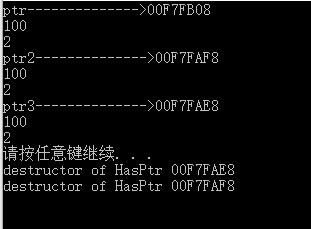
其实程序运行到第二个析构函数时,报错了。报错原因是,ptr 其实已经是pending指针了,因为这个ptr 指针所指向的地址已经被delete了。
不过我们这里最起码可以知道默认的拷贝构造函数和赋值操作,也是会直接复制指针值的,不是指针所指向的值。是指针变量的值,也就是地址。
所以这里引申出来的问题是:如何管理对象中指针成员的内存? 这个是一个核心问题。
上面的例子,就是默认的方式,但是管理失败了,因为析构函数到最后会删除pending 指针,导致异常发生。
智能指针:
引入一个类U_Ptr,用来管理我们需要在业务对象中需要的指针变量,假设为int *p。头文件如下:
|
1
2
3
4
5
6
7
8
9
10
11
12
13
14
15
16
17
18
19
20
21
|
#pragma once#ifndef __UPTR__#define __UPTR__#include "HasPtr.h"#include <iostream>using namespace std;class U_Ptr{ friend class HasPtr; int *ip; size_t use; U_Ptr(int *p):ip(p),use(1) {} ~U_Ptr() { cout << "destruction:"<< *ip << endl; delete ip; }};#endif // !__UPTR__ |
现在我们的业务对象还是HasPtr。头文件如下:
|
1
2
3
4
5
6
7
8
9
10
11
12
13
14
15
16
17
18
19
20
21
22
23
24
25
26
27
28
29
|
#pragma once#ifndef __HASPTR__#define __HASPTR__#include "U_Ptr.h"class HasPtr{public: HasPtr(int *p, int i):ptr(new U_Ptr(p)),val(i){} HasPtr(const HasPtr &orgi) :ptr(orgi.ptr), val(orgi.val) { ++ptr->use; cout << "coming into copy construction:" << ptr->use << endl; } HasPtr& operator=(const HasPtr &rhs); ~HasPtr(); int get_ptr_value() const; int get_int() const; void set_ptr(int *p); void set_int(int i);private: U_Ptr *ptr; int val;};#endif // !__HASPTR__ |
HasPtr.cpp 实现如下:
|
1
2
3
4
5
6
7
8
9
10
11
12
13
14
15
16
17
18
19
20
21
22
23
24
25
26
27
28
29
30
31
32
33
34
35
36
37
38
39
40
41
42
43
|
#include "stdafx.h"#include "HasPtr.h"#include <iostream>using namespace std;HasPtr& HasPtr::operator=(const HasPtr &rhs){ ++rhs.ptr->use; if (--ptr->use == 0) { delete ptr; } ptr = rhs.ptr; val = rhs.val; return *this;}HasPtr::~HasPtr(){ cout << "destruction:" << ptr->use << endl; if (--ptr->use == 0) { delete ptr; }}int HasPtr::get_ptr_value() const{ return *ptr->ip;}int HasPtr::get_int() const{ return val;}void HasPtr::set_ptr(int *p){ ptr->ip = p;}void HasPtr::set_int(int i){ val = i;} |
测试类如下:
|
1
2
3
4
5
6
7
8
9
10
11
12
13
14
15
16
17
18
19
20
21
22
23
24
|
// SmartPointer.cpp : 定义控制台应用程序的入口点。//#include "stdafx.h"#include "HasPtr.h"#include <iostream>using namespace std;int main(){ int *temp = new int(100); HasPtr ptr(temp,22); cout << "ptr------------>" << endl; cout << ptr.get_ptr_value() << endl; cout << ptr.get_int() << endl; HasPtr ptr2(ptr); cout << "ptr2------------>" << endl; cout << ptr2.get_ptr_value() << endl; cout << ptr2.get_int() << endl; system("PAUSE"); return 0;} |
我们把U_Ptr 叫做智能指针,用于帮我们管理需要的指针成员。我们的业务对象HasPtr对象包含一个智能指针,这个指针在HasPtr 对象创建时创建,智能指针的use 变量用来记录业务对象HasPtr对象被复制了多少次,也就是说,有多少个相同的指针指向了ptr所指向的地方。如果要记录HasPtr对象一共有多少个一样的,那么就需要在拷贝构造函数和赋值操作处进行对use变量加一操作,在析构函数处进行减一操作。当减到0时,删除指针。
原文链接:http://www.cnblogs.com/lucy-lizhi/p/6551308.html

